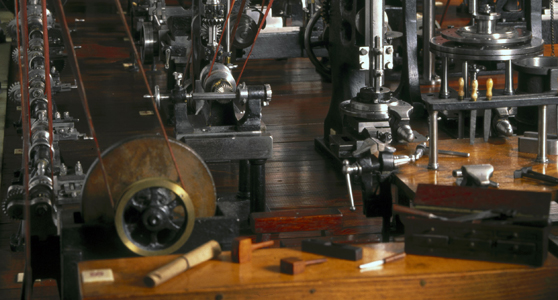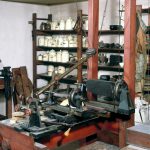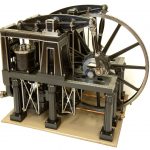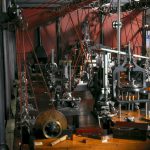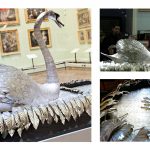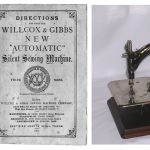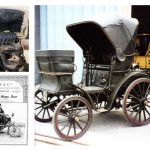Challenges of conservation: working objects
Abstract
https://dx.doi.org/10.15180/160608/001This paper discusses the concepts and practice of museum conservation, and the role of conservation in preserving both material and significance of objects. It explores the conservation of science and industry collections and the fact that the significance of many of these objects lies in their operation. It considers alternatives to operating original objects but emphasises the value of experiencing the real thing, and argues that visitors should be given greater physical access to museum objects, including being enabled to handle and work functioning objects. It finishes by calling for research into the effects of operation on the objects themselves, and into what constitutes a satisfying experience of working objects.
Keywords
Conservation concepts and practice, conserving science and industry collections, operating objects, physical access, research
Introduction
https://dx.doi.org/10.15180/This paper was given at the conference held to inaugurate the Science Museum’s new Dana Research Centre, in Spring 2016. The collections in the Museum are catalysts for research into scientific and technical developments, and their conservation is one of the ways in which they are made available for study and enjoyment. Processes of conservation take place largely ‘behind the scenes’, so this paper aims to explore the concepts and practices of conservation, and their relevance to industrial collections. It is influenced by my view that we should not only display museum objects but make them physically accessible through handling and investigation, and that research is needed into how to achieve this successfully.
That I come from a family of designers and makers has shaped my interest in science and technology collections. As a child I spent many hours amongst the lathes in my father’s traditional workshop – so Watt’s workshop seems entirely familiar to me (see Figure 1) – and many hours at the local railway station watching steam trains. Our village still had a wheelwright, a saddler and a farrier. I am now an archaeologist and conservator and keen to support the conservation of artefacts associated with traditional technologies, some of which have all but disappeared, and the recognition of the skills involved in their use.
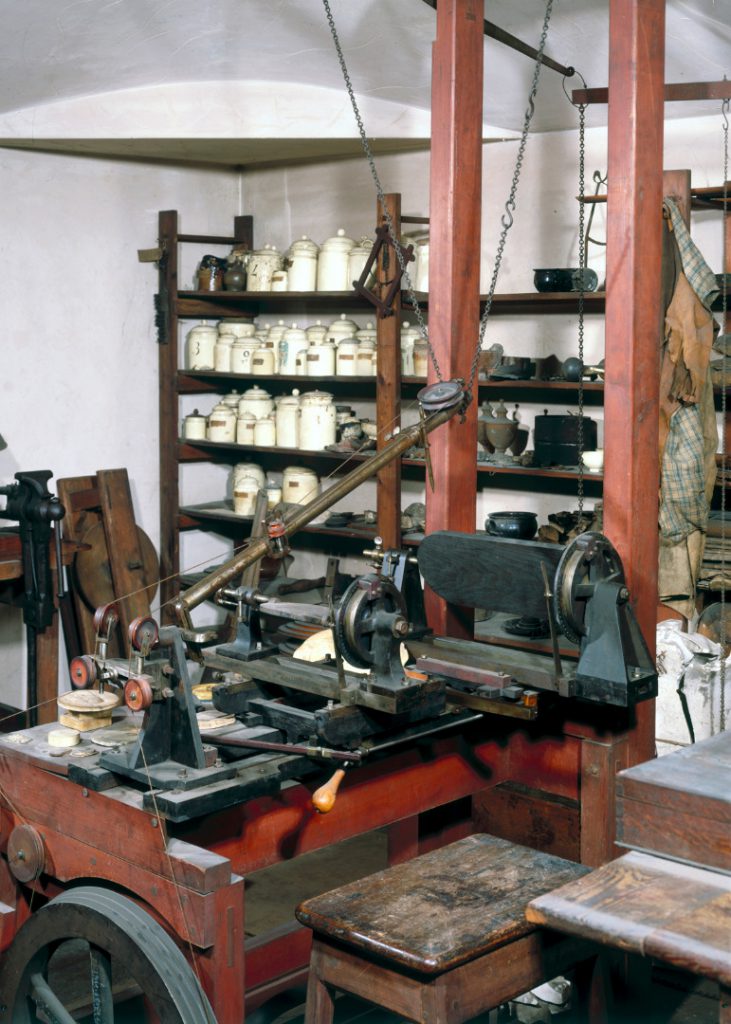
My title refers to ‘working objects’, which is a play on words in that I consider that all objects are in some sense working in the museum (or have the potential to) – otherwise why are they there? Of course, a tighter definition would relate to objects containing moving parts where the motive power is provided by the human body (e.g. a treadle lathe, or manual sewing machine) or through descending weights or coiled springs (e.g. clocks) or by steam, electricity or other forms of separately generated power (see Figure 2). Although museum objects are no longer in context and use, they still have much to contribute to our understanding of heritage. In this sense they do not die when they enter the museum but should remain in ‘active service’ (Farnsworth, 1997).
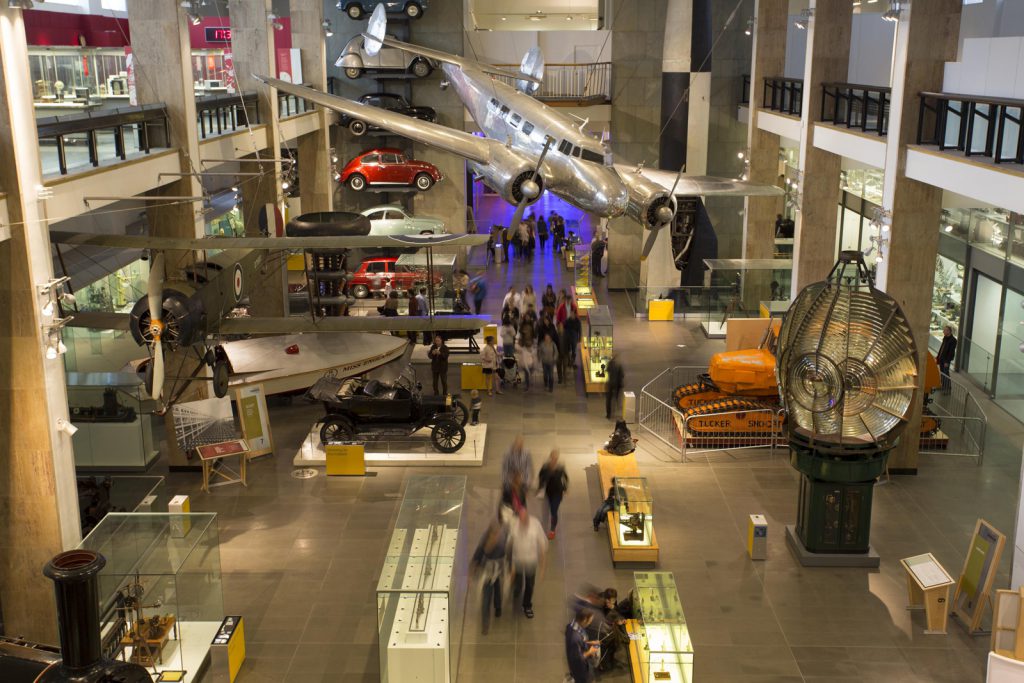
Conservation
https://dx.doi.org/10.15180/160608/002Conservation emerged from the crafts of making and repairing objects. Not surprisingly, conservation at this museum developed from an engineering tradition of maintenance, keeping machinery in working order (so might involve regular lubrication, replacement of worn parts, removal of damaged varnish or paint, repainting, and so on). During the twentieth century there was a shift in the practice and philosophy of museum conservation towards a more scientific approach which sought to understand the chemistry of materials and the way they deteriorate, and to develop ways to prevent or halt deterioration (Rathgen, 1905; Plenderleith, 1998; Gilberg, 1987). At the same time a more conservative approach was evolving – aiming to retain as much of the fabric of the original object as possible.
Now in the twenty-first century the focus has broadened considerably to embrace questions about the motives for conservation: why are these objects being conserved; who is interested in them; and what do they want to know or experience? The emphasis now is on the whole object – not just its material constituents but what it may mean – its significance (Caple, 2000; Pye, 2001; Muñoz Viñas, 2005; Richmond and Bracker, 2009).
Conservation today has evolved from the narrow purpose of practical repair to a well-developed discipline with its own ethics and philosophy. In major museums conservators work as part of a wider team including curators and scientists – each member contributing to an understanding of the whole object, and to conservation decisions (Ward, 1986; Pye and Sully, 2007). The conservation procedure chosen is shaped by the ethos of the museum, the principles of the conservation profession, and by the views of those with an interest in the object. Consultation of interest groups, and sometimes their involvement in the conservation process itself, has led to the evolution of what is becoming known as social or public conservation (Clavir, 2002; Sully, 2007; Salomon and Peters, 2009).
The aims of conservation
https://dx.doi.org/10.15180/160608/003All materials decay over time, even when housed in apparently beneficial conditions; some will change imperceptibly, some more rapidly. Conservation has two main aims: the first is to limit the rate of decay, because it leads to loss of information and significance in heritage objects. The second is to make objects physically and intellectually accessible to those interested in them (scholars, enthusiasts, museum audiences, and so on) (Keene, 2008; Pye, 2008; Saunders et al, 2008). The foundation beneath both these aims is the need to understand objects in all their complexity – fabric, structure, function, meaning (Pye, 2001; de la Torre, 2002 and 2013).
How an object may be made accessible will be dictated in part by its material condition, in part by what people want to know and experience, and importantly by the role it is to play in the museum. So, it may be used as part of an exhibition (where it will be exposed to light), or in a project working with the elderly (where it may be handled), or it may be the subject of scientific investigation (during which it may be sampled for analysis). Each of these situations will have their own risks so whether an object is considered suitable for any of these purposes will be a matter of discussion and negotiation. Modes of access may range from being able to view a fragile item only under closely controlled conditions in a display case, to being able to handle and manipulate an object, or even try it out (Feinup-Riordan, 2003).
Conservation concepts and practice
https://dx.doi.org/10.15180/160608/004A number of concepts guide conservation practice. These have developed over the last half century, but are rooted in earlier thought and deliberation (Ashley Smith, 1982; Stanley Price, 1996; AIC, 2016; ECCO, 2016; Icon, 2016). It is often argued that the most ethical approach to conservation is to accept an object in its current material state and, as far as possible, to prevent further change (preventive conservation). This normally involves modifying and controlling the environment in which objects are housed or displayed (Williams, 1997; Caple, 2012; Staniforth, 2013). However, few objects are stable or undamaged – there may be a spot of corrosion, or a loose component, which needs to be dealt with in order to ensure the safety of that object. It is generally agreed that as conservators we should aim to retain original material, and that conservation treatment should involve doing only what is necessary to ensure the desired safety and stability of the object, and no more. This is often described as ‘minimum intervention’ (Muñoz Viñas, 2009). Just because we could do something more is no justification unless it would make a real difference to the long-term stability or understanding of the object. The concept of minimum intervention may sometimes seem contradictory in practice because in some cases the condition of an object is such that it actually requires very extensive treatment, and regular maintenance, to ensure some form of continued existence and accessibility. This is the case with highly degraded waterlogged wood, which would simply shrink and collapse unless fully treated – the Tudor warship the Mary Rose being a good example (Pearson, 1987). Although lengthy and complex, the treatment given was still the minimum required to secure the future of the ship and to provide some form of access to visitors.
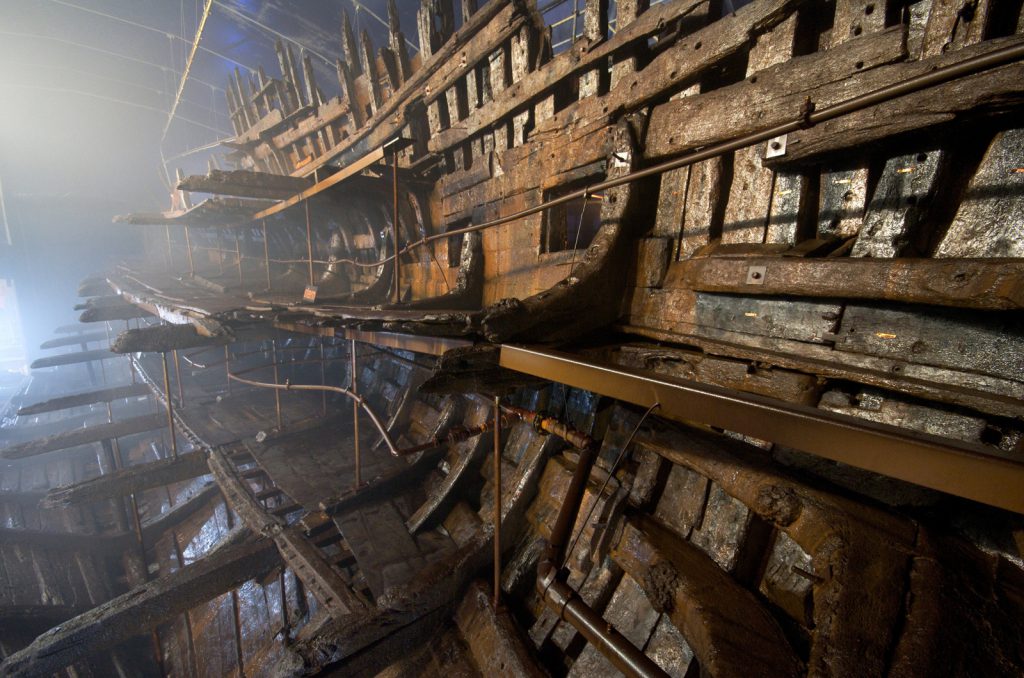
Conserving the material of objects
https://dx.doi.org/10.15180/160608/005That objects are given conservation attention depends very frequently on the way they are to be used in the museum, for example in a special exhibition. How they are conserved then depends on their materials and condition, and available resources such as time, and expertise.
The assessment of condition requires an understanding of materials and the causes and effect of deterioration. Some materials are durable and others much less so. Conservators often talk in terms of ‘inherent vice’ (perhaps more clearly expressed as inherent fault) when considering materials which deteriorate very readily, such as paper. A good example of material suffering from inherent fault is doped fabric used on early airplanes, of which there are several examples in the Science Museum collections (Regel et al, 2016).
Inherent fault is also an issue with many plastics – which are now entering museum collections either as complete objects, or as components in composite objects (e.g. Sale, 1995). It also applies to the modern synthetic polymers (plastics) used as conservation adhesives or consolidants. Conservators aim to use only those with known, reliable and predictably stable properties, while understanding that even these will slowly change (Horie, 1987; Shashoua, 2008). For this reason, conservation scientists have an important role in testing modern synthetic polymers for potential conservation use.
It used to be held that all treatments should be reversible (that it should be possible to undo a treatment and return to the state of the object before treatment), but this concept has been largely discarded as true reversibility is seldom, if ever, possible (Oddy and Carroll, 2000; Muñoz Viñas, 2005). The fact that change will inevitably continue, both in object and in added conservation materials, brings the need to anticipate further conservation in the future (and, we hope, innovations in conservation methods and materials). So the aim is to design treatments now to allow for retreatment in the future, or at least not to hinder it (Appelbaum, 1987). This need to encompass future treatment also means that the materials and processes used must be fully documented so that future conservators can make informed decisions.
Conserving visually accessible objects
https://dx.doi.org/10.15180/160608/006A conserved (materially stabilised) object may not be an understandable (accessible) object. For this reason conservators may use additional processes aimed at making the object more visually complete (often known as ‘aiding interpretation’). This may involve reconstructing a broken object so that its shape and function are apparent (as in reconstructing a ceramic vessel). However, in some cases an object may not be understandable without also reconstructing missing features, thus in easel paintings areas of loss are tactfully/minimally repainted so that the image can be ‘read’. This is generally known as restoration but a useful phrase sometimes also used is ‘compensating for loss’ which, to me, indicates more clearly that this process does not restore the substance of the original, but aims only to reinstate something of the original appearance. It indicates a cautious approach, in accordance with the idea of minimum intervention, where features that are lost are suggested or approximated, guided by the remaining evidence (Oddy, 1994; Philippot, 1996; and see Stanley Price, 1996: Parts V and VI).
Conserving significance
https://dx.doi.org/10.15180/160608/007Objects are more than just material things – they have meaning (significance) for people. Assessment and conservation of significance depends on consultation and on understanding and weighting the many possible views of those with an interest in an object. The curator may see a machine as a rare example of a particular technical development, the scientist may be interested in the types of alloy used, the visitor may have memories of similar machines in use, and may have nostalgic feelings about motion, smell and sound. Any one object may garner a range of reactions so carry a range of values – which together constitute its significance (de la Torre, 2002 and 2013; Clavir, 2002).
Values may shift – an example often used is the vintage car which starts life as a valued family vehicle then passes through a stage of being considered redundant and fit only for the scrap-heap, before being lovingly rescued and proudly displayed at specialist rallies (Appadurai, 1986). Values may conflict – a Stradivarius violin may be valued by a historian for its unaltered state (so never played), whereas a violinist may yearn to discover how it feels when played and to hear its tone, or to play an instrument which was played by great violinists in the past (Barclay, 2005; Lamb, 2007).
Another element in the significance of an object is what is termed its ‘biography’. This is compounded of factors such as the makers’ intention (what was it for, why was it made and why was it made in the way that it was); what has happened to it since it was made; its associations with people and/or events; what it means to people now (and what it may mean in the future). So an object’s significance can be seen as the accretion of everything that has happened to it physically (including repairs and conservation) and the accumulation of different values (Peers, 1999; Marshall and Gosden, 1999; Joy, 2009).
Not only will significance influence conservation decisions but a decision may need to be made about which stage of an object’s life is most important and so should be prioritised during conservation. Should the evidence of use be retained or should conservation aim to reinstate an earlier appearance? Like the example of the vintage car, some historic houses are conserved and displayed as in their prime with rewoven textiles and fresh gilding; by contrast others are presented as in their decline with worn carpets and faded paintwork.
Conservation decisions
https://dx.doi.org/10.15180/160608/008Thus a range of factors relating to both material and significance is considered by curators and conservators before making a decision on conservation treatment. There is seldom just one possible course of action, so various conservation options are considered and the risks and benefits of each are weighed and compared (Brooks et al, 1996; Eastop, 1998; Pavelka, 1999). Does the condition or the significance of this object rule out a proposed use, or might it be possible to reach a conservation compromise which would enable this use to be accommodated? Do all possible treatments pose some risk to material or meaning, but does doing nothing carry an even greater risk? Not only the materials and processes used but the perceived significance of objects and reasons for the particular conservation decision should be fully documented. This ensures that future conservation actions are based on understanding the state of the object at the time, and the thinking which influenced conservation choices.
Conservation and controversy
https://dx.doi.org/10.15180/160608/009Conservation usually involves some modification either to the environment or to an object itself, so it can change either the substance or the perception of an object (or both). Obviously, removal of harmful accretions, or addition of a consolidant, will affect the material character, but even the preventive process of putting an object in a purpose-designed protective box or mount can change the way it is viewed and thus valued. Because it involves choices and sometimes compromise, conservation is not a neutral activity, and can be controversial.
Perhaps one of the most controversial and tricky actions a conservator can take is to clean an object (to remove accretions such as dirt, or decayed varnish, or metal corrosion) in order to retrieve original detail and appearance. In everyday life cleaning is normally seen as a harmless, even laudable action, but in conservation it can be the subject of serious debate (Hedley, 1986 and 1990; Bomford and Leonard, 2004: Part VI). Some people prefer the familiar look of age so the ‘new’ appearance of a cleaned stone sculpture or painting can be perturbing (see Stanley Price, 1996: Part VII). However, retaining the familiar uncleaned state conflicts with the aim of recovering original surface information (and removing harmful substances). The lay viewer may not necessarily be aware of the state of the object or of the many deliberations which may have taken place before a decision is taken on whether to clean, how to clean and how far to go. There have been a number of controversies focused on the cleaning of paintings (Bomford, 1994; Bomford and Leonard, 2004: Part VI), and on the cleaning of sculpture and glass, some of which have been energetically publicised by ArtWatch International and its UK branch on their websites (ArtWatch, 2016). A current example of controversy is the cleaning (and restoration) of the interior of Chartres Cathedral in France (Calvel, 2014).
Surfaces carry information such as tool marks, coatings, libations, even finger prints (Pye, 2001; Caple, 2006). Conservation cleaning is a highly skilled activity, and it is undoubtedly possible to over clean through inexperience, by misjudgement (or even by intention). During the last two centuries many sculptures were apparently cleaned of much of the remaining traces of paint (e.g. Larson, 1997). By its very nature the process of cleaning involves removal of material, but it may be difficult to distinguish physically between the extraneous ‘dirt’ and the original object. Dirt may have penetrated coatings such as varnishes, or fibrous structures such as paper so be almost intermingled with the original. Metal corrosion is formed when the metal of the object reacts with factors such as water or salts in the environment, so inevitably removal of corrosion removes some of the original metal. The appearance of any object after cleaning may seem different and brighter, but cleaning also has an important role in investigation and research. When excavated coins are cleaned the gradual removal of obscuring dirt and corrosion layers may reveal an inscription and hence a date, or when a painting is cleaned the removal of later restorations and other accretions uncovers the artist’s original brushwork and choice of pigments (Caple, 2000; Bomford and Leonard, 2004; Muñoz Viñas, 2005).
Many of those perturbed by the cleaning of Chartres had valued the dark interiors, and air of mystery, so are shocked by a new, and to them unwelcome or even false, brightness. Whereas others rejoice in the revelation of what are considered to be the original colours and design.
Using museum objects
https://dx.doi.org/10.15180/160608/010The conservation concepts outlined above focus on a cautious approach aimed at retaining original material and limiting change. But conservation cannot involve total protection if objects are to have a use in a museum – to make an active contribution to research and enjoyment they must be accessible. So not only are objects cleaned, reconstructed or sampled for research, but they are exposed to hazardous environmental conditions. Paintings and watercolours are routinely exhibited even though it is known that exposure to light is damaging. When lent to other institutions, valuable objects are transported across the world even though this may involve sometimes rapid environmental changes or abrupt movement and vibration. In each case the risks and benefits will be carefully evaluated. Paintings or objects will be selected for display or loan only if considered to be in a suitable state, and specific conditions (such as exhibiting in low light levels, or use of specially designed travel crates) will be agreed and applied; nevertheless, some risk remains when making these uses possible. Consequently there has been extensive research into the effects of the environment on heritage objects, and into ways to mitigate them (Ashley-Smith, 1999; Caple, 2012; Staniforth, 2013).
It is also important to remember that in the whole range of acknowledged heritage there are objects which continue in daily use: listed buildings, eighteenth-century furniture, Stradivarius violins, grandfather clocks, Victorian paintings, wooden sailing yachts. For many or most of these the benefit of continued active life has been achieved as a result of repair, replacement and adaptation, and some loss of original features.
Conserving industrial collections
https://dx.doi.org/10.15180/160608/011How do these aims, concepts and practices of conservation affect industrial collections? There are considerable material challenges in the basic care of industrial objects (Storer, 1989; Dollery and Henderson, 1997; Meehan, 2000; Newey, 2000; Child, 2006). Many, such as steam engines or aircraft, are very large so there are problems of just housing them, let alone providing a suitably preventive conservation environment (Paine, 1994). It is not surprising that many of the Science Museum’s large objects are housed in former hangars on an old airfield. Assessing their materials and condition can be challenging. They are often highly complex and composite objects, constructed of a variety of substances – metals, wood, textiles, lacquers, rubbers and plastics – each with its own problems (Baker and McManus, 1992; Shashoua, 2008). They may contain other substances such as lubricants or traces of fuel, or hazardous matter such as asbestos.
There are also challenges in making working objects accessible as for many people their significance lies in their mechanism and the way they function. However, visitors are normally offered access through viewing the static object (together, of course, with explanatory labels), but just looking at them provides only partial information. An early computer or television with a blank screen can demonstrate size and shape but not what it was like in use; the appearance of a water pump gives little information about function. So how can people engage with the richness of these objects? How feasible is it to operate industrial objects to bring them back to life, and how does this accord with conservation thinking?
Operating working objects: challenge and controversy
https://dx.doi.org/10.15180/160608/012The Science Museum Group’s policy (Burden and Leskard, 2013) sets out formally the factors to be considered when deciding whether to operate objects, and demonstrates the negotiations required to reach a decision.
Operating museum objects raises several issues. For an object to function fully, all the working parts and essential components need to be viable. However, some features such as rubber washers or rubber tyres may be degraded beyond use and it will be necessary to search for replacements, or for suitable modern substitutes (CCI 1997 and 2002). The same will apply to other essentials such as lubricants or fuel. Questions may arise such as whether it is acceptable to power a formerly steam driven mechanism with electricity. It will also be necessary to consider whether staff have the necessary skills to operate the mechanism safely, and whether there are the resources needed to monitor and maintain that mechanism in the longer term. Safety of both operators and audiences is a major consideration. Without effective precautions there may be serious risks to personnel in operating early machinery – such as bursting boilers or limbs caught in drive belts.
One of the main conservation concerns is the risk of damage to the materials of the original, particularly the moving parts. Although many objects will have had some, or even several, parts replaced during their working life, once in a museum the aim would normally be to retain and conserve original material, however worn. Bringing an object back to operating condition may inevitably require some modification to the fabric, and negotiation of conflicting values (Mann, 1994, a and b; Newey and Meehan, 1999; Staelens and Morris, 2010). Factors to consider may include whether it is permissible to replace moving parts, what should be done with the worn original parts, whether it is feasible to replace parts with a different, perhaps stronger or more permanent material, and what the effect might be of this new material in conjunction with the original materials and mechanism.
Preparing a working museum object for operation may run counter to the conservation concepts of retaining original material and of minimum intervention in terms of treatment. On the other hand it does accord with the idea of making an object accessible through compensating for losses (loss caused by wear on moving parts and consequent loss of function). It can be compared with the modification of other types of object to make them understandable – paintings are cleaned to remove degraded varnish or earlier restorations then retouched, decaying timber beams in ancient buildings are replaced or reinforced with metal supports. Even attaching a guard around a drive belt, where none would have existed before, can be compared with the use of protective mounts or boxes for fragile works on paper. It might be considered that exposing parts of a mechanism to continuing wear poses different and greater risks than other forms of use, but exposure of paintings to light risks continuing damage to pigments, and historic buildings, however well cared for, continue to suffer the effects of the weather.
Alternatives to operating original objects
https://dx.doi.org/10.15180/160608/013Can a satisfying experience be provided without operating original objects? The museum’s Fly 360° flight simulation, during which a visitor is invited to ‘take the controls yourself and perform your own aerial acrobatics’, must provide some of the thrill described by Antoine de Saint-Exupéry when writing about his first flight in 1921:
My senses of space, of distance, and of direction entirely vanished. […] I thought I was very high up when I would suddenly be thrown to earth in a near vertical spin. I thought I was very low to the ground and I was pulled up to 3,000 feet in two minutes by the 500-horsepower motor. It danced, it pushed, it tossed …
Full-sized replicas can also provide a satisfying experience – many of the Second World War Spitfire fighter planes still flying are presumably partly or wholly replica but nevertheless highly emotive. Watching a group of them in flight provides an evocative sound and reminds us how small and vulnerable these planes were.

This museum has a magnificent collection of static models (which are impressive objects in their own right), many of which can be operated at the push of a button to demonstrate the movement of component parts. Is movement alone sufficient when it may be impossible to provide the context in which the machine would have operated? Taking examples displayed in the museum, the model of the double-beam engine (made in Bolton in 1804) is a beautiful object, running impressively smoothly, but without obvious context its purpose is not immediately clear (see Figure 5). On the other hand, to me, the model Victorian workshop does show successfully how many machines could be run off one engine and just how crowded and busy (and certainly noisy) such a workshop would have been (see Figure 6).

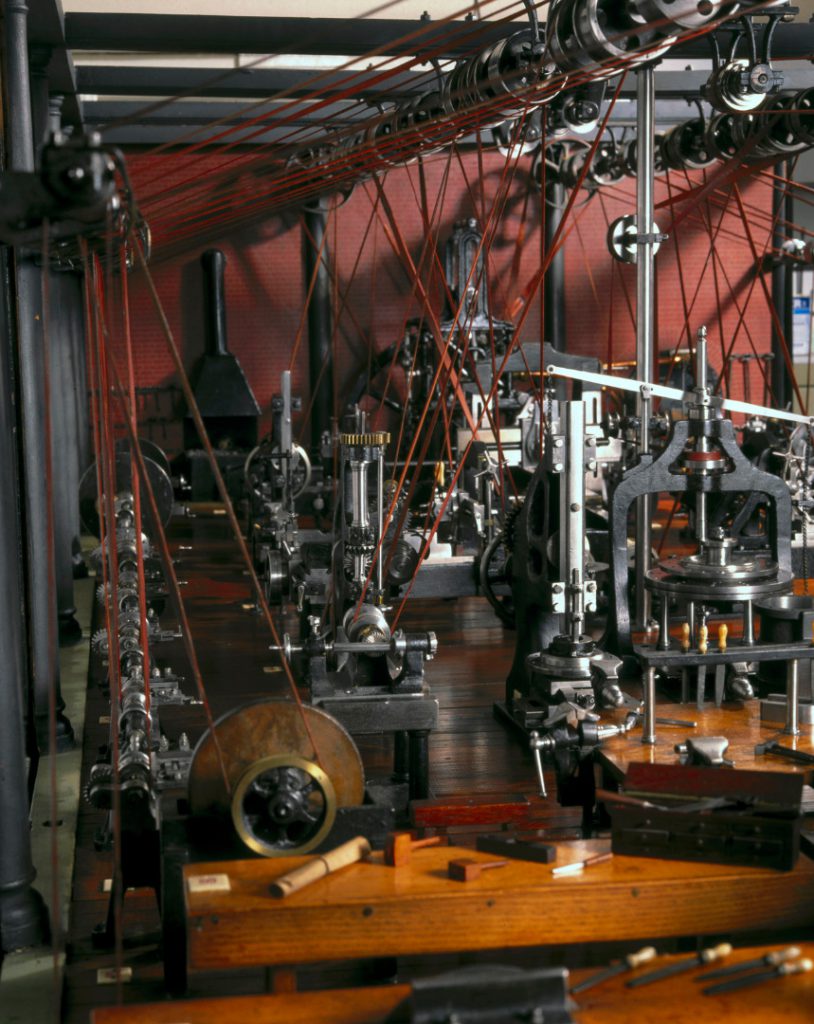
Looking into the future, perhaps 3D digital imaging and virtual haptics will enable us to handle and operate virtual objects thus avoiding risk to the original. But how satisfying will this be when it seems likely to eliminate idiosyncratic behaviour of mechanisms and the consequent need for skilled handling (MacDonald, 2006; Prytherch and Jefsioutine, 2007)?
Experiencing the real thing
https://dx.doi.org/10.15180/160608/014These substitutes cannot provide the genuine sounds and smells and the sense of being fully immersed in the past. For many people it is the experience of the real thing which has the emotive power.
Here is a 1950s childhood memory of William J Mitchell:
Every evening the express train from Melbourne came thundering into town – passing through, and barely pausing on its way to Adelaide. You could hear the whistle blowing – with urgently increasing intensity, then a mournful, gorgeous Doppler shift – from miles away across the starlit plains. The locomotive was a magnificent smoking, hissing, clacking monster sporting a glowing firebox, a tender heaped with filthy coal, and huge, shiny wheels. It was my earliest intimation of the technological sublime.
The enthusiastic crowds recently gathered at King’s Cross station and along her route show that Flying Scotsman not only provides an exciting experience compounded of steam, sound, smell and speed, but is apparently highly emotive for those who remember steam trains, and amazing for those experiencing one for the first time (McLean, 2016).

Seeing an object in movement may be very revealing of design and manufacturing skills. The famous eighteenth-century musical swan automaton in the Bowes Museum (County Durham) is a beautiful object when static but once in motion it becomes possible to see how cleverly the effect of the swan catching a fish was devised, and how ingeniously the rotating glass rods represent flowing water (Bowes Swan, 2008 and 2016).
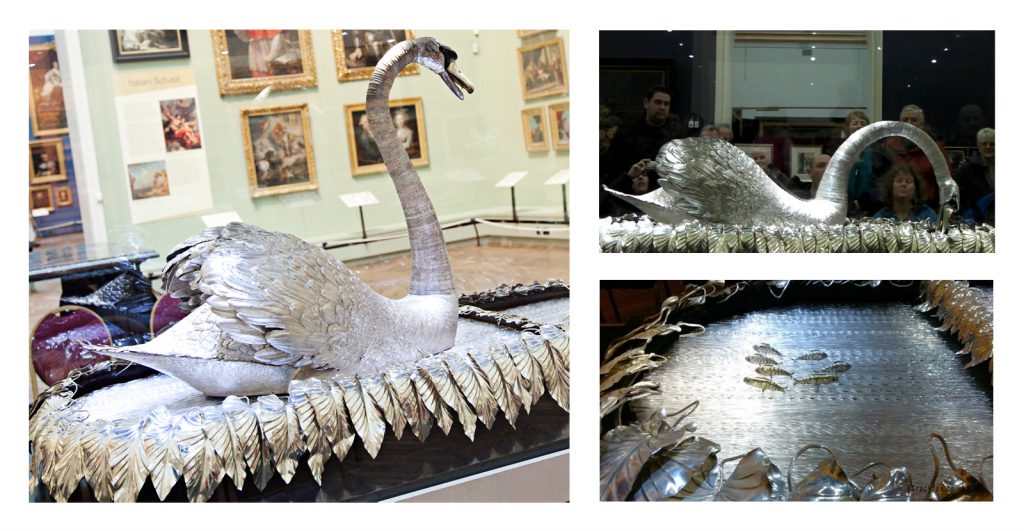
It seems that in this increasingly ready-made/touch-screen age people want to regain the experience of making or doing things for themselves, particularly to re-learn technologies which require practical skill. This is evident in the resurgence of traditional crafts, e.g. basket making or hand knitting (and in frequent craft fairs), in the enthusiasm for restoration and operation of steam traction engines or vintage cars, as seen in the numbers of amateur groups, and in the general interest in making (Charny, 2011; Gauntlett, 2011).
Benefits of operating objects – enriching visitor experience and wellbeing
https://dx.doi.org/10.15180/160608/015As conservators we are professionally responsible for the long-term survival of the objects in our care, but we also have a responsibility towards people. Much of what is offered in museums relies on visitors using their visual sense alone, when in fact we use all our senses in our daily lives. We use our hands to explore and understand the material world around us; our senses of hearing, smell and taste are intimately linked to our well-being. Over the last few years there has been an increasing interest in the senses generally (see for example Classen, 2005; Vannini et al, 2012; Howes and Classen, 2014).
As long ago as 2002 a report for the Museums Libraries and Archives Council in the UK (then Resource) concluded that more museum objects could be made available for touch and handling (Munday, 2002). More recently the importance of touch as a way of interacting with museum objects has been explored at a number of conferences and workshops and gradually the old ‘do not touch’ rule in museums is being re-evaluated (Pye, 2007; Chatterjee, 2008; Conservation’s Catch 22, 2009). Handling unfamiliar objects such as an old black leather bottle can be intriguing; contact with an ancient object such as a precisely flaked Neolithic flint blade may be fascinating. That this form of access is engaging and enjoyable is acknowledged, for example, in the provision of handling desks by the British Museum, and by the National Trust’s attempts to conjure up the ‘atmosphere’ of a country house by providing appropriate sounds and smells and by encouraging visitors to pick things up or sit on the furniture (Cowell, 2009). Interesting work in hospitals has shown that touching, exploring and discussing museum objects can have measurable beneficial effects on the recovery of patients (Ander et al, 2013).
Operating large and complex machinery undoubtedly presents difficulties (of staffing, supervision, and safety). So would operating the more modest stuff of past everyday lives also be engaging? Would it be possible to provide experience not just of handling but of operating some of the smaller objects often sitting passively in large numbers in museum stores? Even partial operation – pressing the keys of an early typewriter, rotating the dial on a telephone, using the treadle on a lathe, or viewing a subject through a plate camera – gives some sense of how different these objects are from their modern equivalents, and what they were like to use.
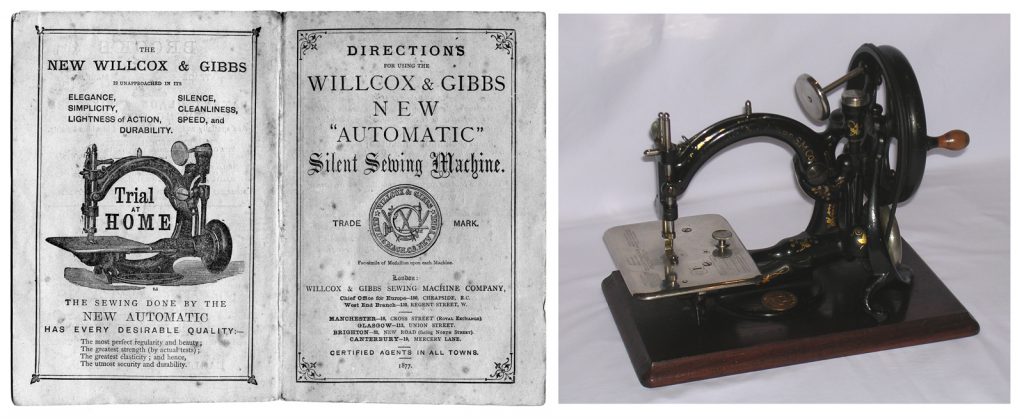
Figure 9 shows a Willcox & Gibbs sewing machine first manufactured in USA in 1857 as ‘the first low-priced…machine for the domestic market’ (Forty, 1986, p 96). This particular one was given to my grandmother on her marriage in the early twentieth century, and is the machine I learned to sew on. It is beautifully made and runs as smoothly as ever; its characteristic sound is an important feature and for this reason it is known in the family as ‘Mutton-mutton’; it also has a splendidly oily smell. Only by operating it myself do I understand its idiosyncrasies, and only by using it have I had an intimate experience of a machine first produced in the middle of the nineteenth century and which must have changed many women’s lives.
Operating objects and research
https://dx.doi.org/10.15180/160608/016Bringing objects back into working state can be an act of research in itself. It becomes possible to work out how machines were constructed and how they behaved. In objects such as the Bowes Swan, or the early Benz motor car restored to working state at the National Museum of Wales (Perry, 2006), dismantling and repair of the mechanisms provided insight into the way they were constructed and how they were operated.
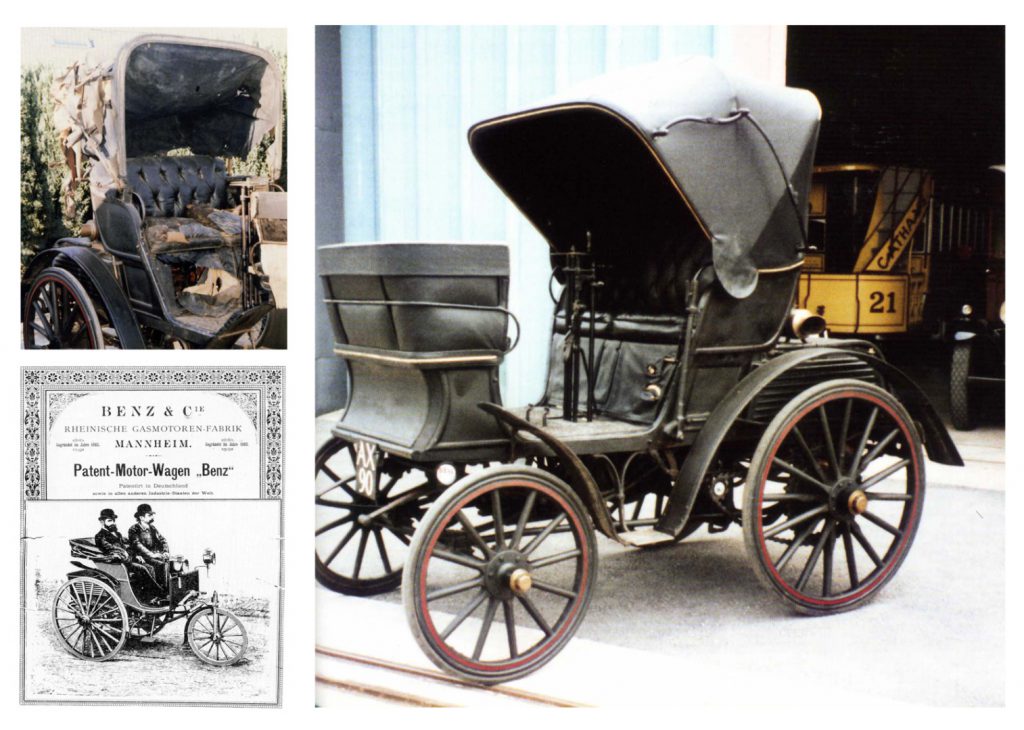
Writing about the motor car Chris Perry said:
The curators and conservators working on this project felt certain that by running the car and maintaining the engine in working order, the display life and potential of the car were being used far more effectively than leaving the engine rusted and seized up […] there is always an element of compromise with preserving and displaying complex vulnerable materials if they are also to remain part of a public, accessible collection.
Perry, 2006, p 150
The business of operating historic objects opens up two other areas of research. The first is the need to understand the effects on the objects. Although there has already been extensive research into the effects of light and humidity on museum objects, and of different types of packaging for transport, little is known about both short and longer term effects of touching, handling and manipulating different types of object, nor about methods of detecting, preventing or mitigating possible damage.
The second area for research is the evaluation of the experience provided to participants. So, for example, we need to know what types of object are particularly interesting in operation, and to what extent it is satisfying for visitors to watch a demonstration as opposed to enabling them to handle and operate objects themselves. We need to understand the most effective ways of organising the experience, including whether to give detailed information and guidance or to allow visitors to make their own discoveries.
A further aspect is how visitors can themselves contribute to research. Being able to handle and operate objects may prompt memories of working life, may enable individuals to demonstrate the function of objects and exercise their former working skills. The involvement of the public in research projects is becoming increasingly popular, for example Citizen Science projects such as those based at the Natural History Museum, or the use of crowd-sourcing in gathering archaeological data (Tweddle et al, 2012; Bonacchi et al, 2015). There is almost certainly a bank of valuable knowledge and experience of industrial objects which could be drawn upon.
Conclusion
https://dx.doi.org/10.15180/160608/017Just as the image is the essence of a painting, so the function is the essence of a mechanism. Although operating mechanisms brings risks of damage, and has conservation implications, we need to offer the experience of functioning, working objects to visitors. To do this effectively we need to know more about the nature of the resulting wear and damage and how to control and detect them. As technical processes are further and further removed from daily experience, and fewer and fewer mechanisms are operated manually or require skill, we owe it to visitors to give them an enhanced understanding of the scientific achievements of the past. This seems to me to be the essence of social conservation, and the way to give people experience of technological ingenuity and achievement, or even (in William Mitchell’s words) some ‘intimation of the technological sublime’.
Acknowledgements
I am very grateful to all the following for discussion of the subject of this paper: Nicholas Balaam, Louisa Burden, Richard Horton, Jannicke Langfeldt, and to the anonymous referees for their comments.

